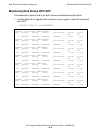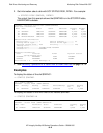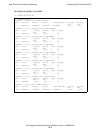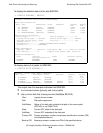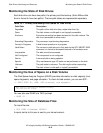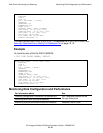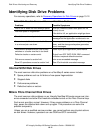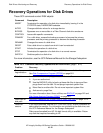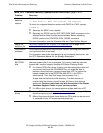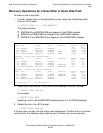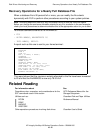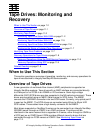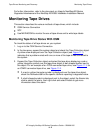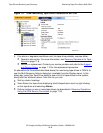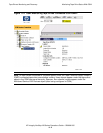
Disk Drives: Monitoring and Recovery
HP Integrity NonStop NS-Series Operations Guide—529869-005
10-13
Recovery Operations for Disk Drives
Unspared
defective
sectors
To check for unspared defective sectors with SCF:
-> INFO DISK $*, BAD, SEL started, sub magnetic
To check for unspared defective sectors with DSAP at a TACL prompt:
> DSAP $*
•
Recovery for DSAP is not needed.
•
Recovery for DCOM: use the SCF INFO DISK, BAD command on the
affected disk to obtain the bad sector address. Before restarting
DCOM, perform the CONTROL DISK, SPARE command.
For more information, see the Guardian Disk and Tape Utilities Manual.
Nearly full
database file
Recovery Operations for a Nearly Full Database File
on page 10-15
Performance
problems
Performance problems can have various causes, including path switches
or a cache size that is too small.
For information about disk load balancing and increasing cache size, see
the SCF Reference Manual for the Storage Subsystem.
Corrupt
$SYSTEM
disk
If both halves of your mirrored system volume become corrupted, use an
alternate system disk if one is available. For how to create an alternate
system disk, see the Integrity NonStop NS-Series Planning Guide.
•
For internal SCSI disk drives: if there is no alternate system disk and
you cannot load from the CONFBASE file, you might be able to
perform a tape load from a system image tape (SIT) to restore the
system image files to the $SYSTEM disk (SYSnn and CSSnn
subvolumes). Then load that image into processor 0 or 1.
A tape load reinitializes the disk directory. The disk directory is
overlaid with the directory from the tape. All files on that disk are
destroyed. Perform a tape load only with the advice of the Global
Customer Support Center or your service provider.
•
For M8xxx disk drives: you cannot perform a tape load from a SIT.
Failed disk
drives
•
Internal SCSI disks: the Support and Service Library on page 1-12
describes replacing disk drives.
•
M8xxx fibre channel disks: these disks are FRUs and can be serviced
or replaced only by HP-trained service personnel.
Table 10-3. Common Recovery Operations for Disk Drives (page 2 of 2)
Problem Recovery



